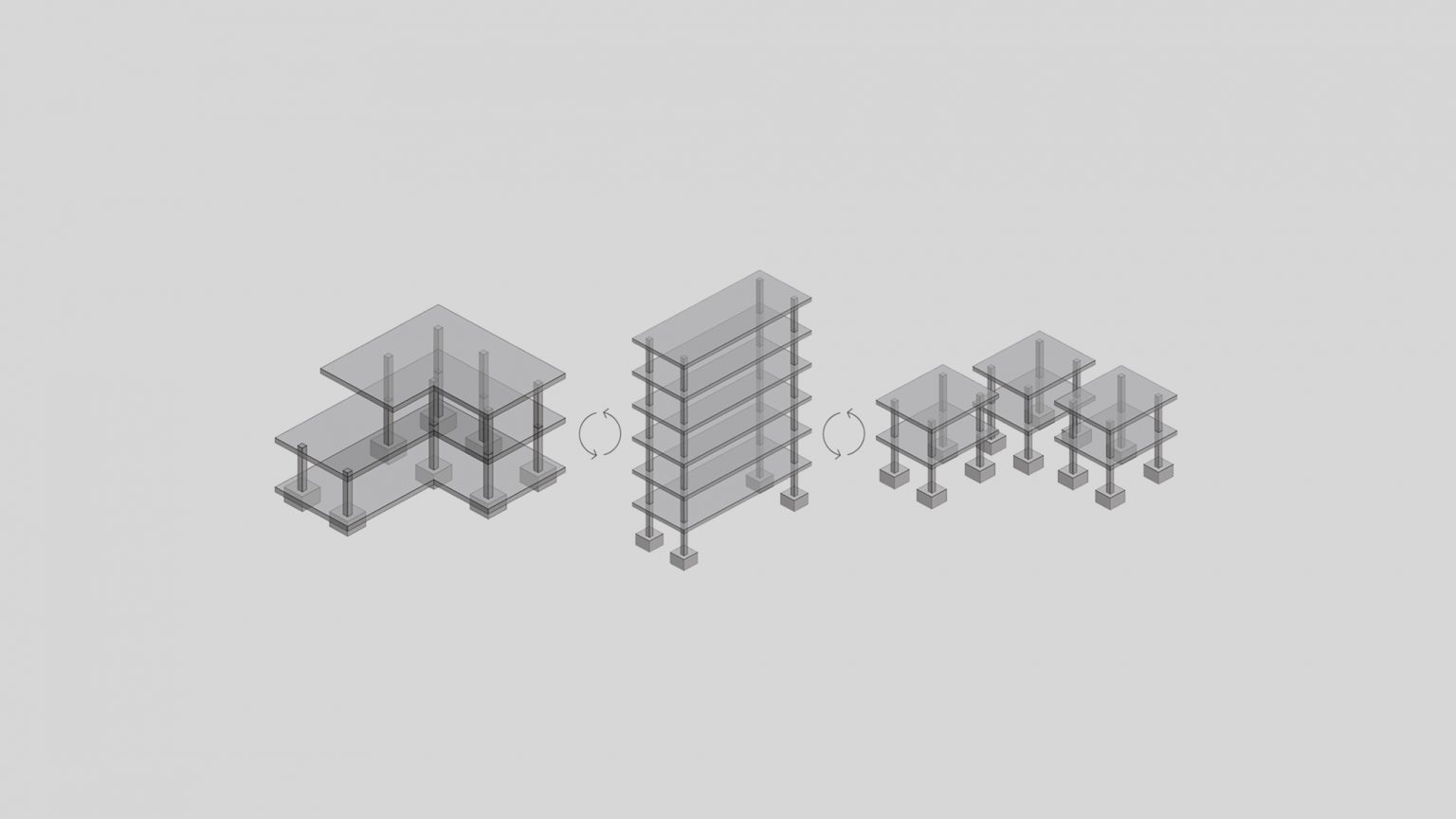ready-for-reuse building structures
Building uses evolve but construction material remains. In order to keep up with the constantly updated needs of our society, we renovate our buildings. More precisely, we replace their envelope or inner wall partitioning. And we try to keep their structural skeleton in place as long as possible. Despite modern developments in modularity, however, market requirements will sooner or later push the structural skeleton to be demolished as well and to leave room for a brand new one. But processing raw material for the construction industry has substantial environmental costs. Whereas solutions exist to design new building envelopes, finishing and equipment that allow their reuse, no robust and global solution exists to effectively reuse structural load-bearing systems after deconstruction.

Our aim is to design a highly-versatile load-bearing system for 6-story-high office buildings that can be disassembled and reassembled in new spatial configurations two to three times over a life-span of 200 years. While fulfilling certain boundary rules (maximum span, etc.), we allow the positioning of columns to be as open as possible in order to allow any unpredicted use and transformation of the building.
Full-scale prototypes have been tested. A patent request has been submitted. We will soon be delighted to publish more about it.
Please note that the publication lists from Infoscience integrated into the EPFL website, lab or people pages are frozen following the launch of the new version of platform. The owners of these pages are invited to recreate their publication list from Infoscience. For any assistance, please consult the Infoscience help or contact support.
Sustainability through reuse: a reconfigurable structural system for residential and office buildings
Current load-bearing systems for buildings rarely have a beneficial end of life. Modular design is a proven solution for revalorizing obsolete structures, but it hardly competes with conventional solutions: the range of future spatial configurations that the modules will accommodate is usually too limited to balance additional upfront costs due to necessary oversized elements and extra connections. Through a review of building demolition cases, this paper first presents motives, challenges and requirements for overcoming adverse end-of-life environmental impacts of building structures. Then a new structural system addressing the specified design constraints is introduced. The system is a highly versatile kit of slab and column elements. Contrary to existing modular solutions, its element dimensions do neither constrain the positioning of columns nor the shape of floor plans. Slab elements are stacked vertically to tune bending and shear stiffnesses locally and ensure serviceability requirements for a wide range of column and load cases layouts. All connections between elements are reversible and ready for reuse. Accordingly, the proposed structural system is well-suited for multiple service cycles and architectural needs, mitigating the detrimental effects that buildings have on the environment.
2020-11-02. Beyond2020 – World Sustainable Built Environment, Online, November 2-4, 2020.

Please note that the publication lists from Infoscience integrated into the EPFL website, lab or people pages are frozen following the launch of the new version of platform. The owners of these pages are invited to recreate their publication list from Infoscience. For any assistance, please consult the Infoscience help or contact support.
Design Space of Modular Slab Systems with Discrete Stiffness Distribution and Irregular Column Layout
A known challenge of modular structural systems is to avoid the oversizing of its elements while allowing a wide variety of spatial layouts. Considering any given floor outline and the availability of square slab elements with three discrete bending and shear stiffness, this paper explores: 1) the minimal geometric and topological rules that ensure a positioning of columns satisfying serviceability requirements; and 2) for a given satisfying positioning of columns, the distribution of slab elements that minimizes the overall weight of the system. This study is part of a larger project aimed at developing a highly flexible floor system whose element dimensions do not constrain the positioning of the columns nor the shape of the floor plan. Hence, the structural system could be adapted over time to changing architectural needs.
2018-07-16. IASS Symposium 2018, MIT, Boston, Massachusetts, USA, July 16-20, 2018.
Other publications:
- Design of Load-Bearing Systems for Open-Ended Downstream Reuse
SBE conference 2019 (detailed record)